During the holiday season each year, bird watchers can be found spending hours patiently watching Whidbey Island’s bluffs for avian activity, binoculars in hand.
These aren’t your average bird fanatics. Rather, Whidbey Audubon Society volunteers compile data to count the island’s bird populations. The work is just a sample of Audubon’s contributions, and considering the organization will celebrate it’s 35th anniversary this week, those contributions likely won’t stop there.
“There is an ever-increasing need for organizations like Audubon that are dedicated to protecting and conserving critical habitats on Whidbey Island,” said Ann Casey, a member of Audubon’s board. “We just try to meet that need by helping to shape county policy, presenting our concerns and having members who sit on advisory boards.”
To commemorate its milestone, Whidbey Audubon Society is hosting a potluck dinner celebration at 6 p.m. Thursday evening at the Coupeville Recreation Hall. The event will reflect on the organization’s past accomplishments but also offer a glimpse into its current and future efforts. The story of Hazel Wolf, Whidbey Audubon’s founder who started “about 80 percent of Audubon communities in rural Washington” will also be presented at the celebration.
The organization will honor two citizen scientists who spent the last 12 years compiling data on Whidbey Island’s native Pigeon Guillemot as well. Phyllis Kind and Frances Wood will be presented with the Whidbey Audubon Excellence Award for their lead roles in the effort to log baseline data for the black seabird with bright red feet, such as population, breeding patterns and feeding habits. It’s the first data set of its kind, and was published to the peer-reviewed science journal, Northwest Naturalist.
The data has since been referenced in a number of journals by researchers since then.
“Giving out the excellence award is rare for us,” Whidbey Audubon Society board president Sharon Gauthier said. “We’ve only handed it out three or four times. But, Phyllis and Frances deserve recognition for all of their volunteer hours.”
Although being referenced by the larger science community is a feat for the group, Audubon members will say the citizen science is just a facet of the organization’s mission to educate the community on local bird species and land stewardship. Wood said the educational arm of the nonprofit is really what has developed since she became involved with Audubon about 20 years ago; the group has expanded to offer workshops for adults and youth alike, educational field trips and has worked with the island’s schools.
Within the past year, Audubon has also established a bird specimen library, which has collected a wide range of species. It’s set up for special events or at places like the high school or senior center. Visitors can read displays and even pick up specimens for close inspection.
“Very few chapters have a permit to prepare birds like we do for the specimen library,” Casey said. “The library gives people the rare experience of actually holding the bird in their hand. I think that’s important for kids to recognize the different species, because familiarity can lead to better stewardship.”
Audubon has also left its fingerprints on Island County through the organization’s representation on various county advisory boards, specifically those related to or concerning environmental policy and regulation. Gauthier says the group provides county decision-makers with a valuable perspective, which can help shape proposed legislation.
Recently, Audubon has worked with the county regarding the critical areas ordinance update. The group has a history of advocating for the protection of significant wildlife habitat areas, and has established critical areas such as Deer Lagoon. According to Gauthier, the research Audubon volunteers have conducted has lead to the protection of areas from toxic spills. The organization continues to promote land stewardship by discussing sustainable logging practices with private property owners.
“What I have seen is that, because we’re involved in committees as we look at ordinances, we help the county look at things from a different lens,” Gauthier said.
The Audubon’s work is important, not just locally but on a much larger level. Casey says many birds like the Pigeon Guillemot are indicator species that will help scientists recognize when rapid habitat change is occurring. Studying the birds can help give researchers an idea of why environment changes might occur, and what Puget Sound residents can do to slow those changes.
Expect to see those volunteers counting the seabirds once again this Christmas, patiently recording data.
“At the core, Audubon helps people in the community see what’s here so they can value it,” Gauthier said. “That ultimately helps promote the life on island.”


